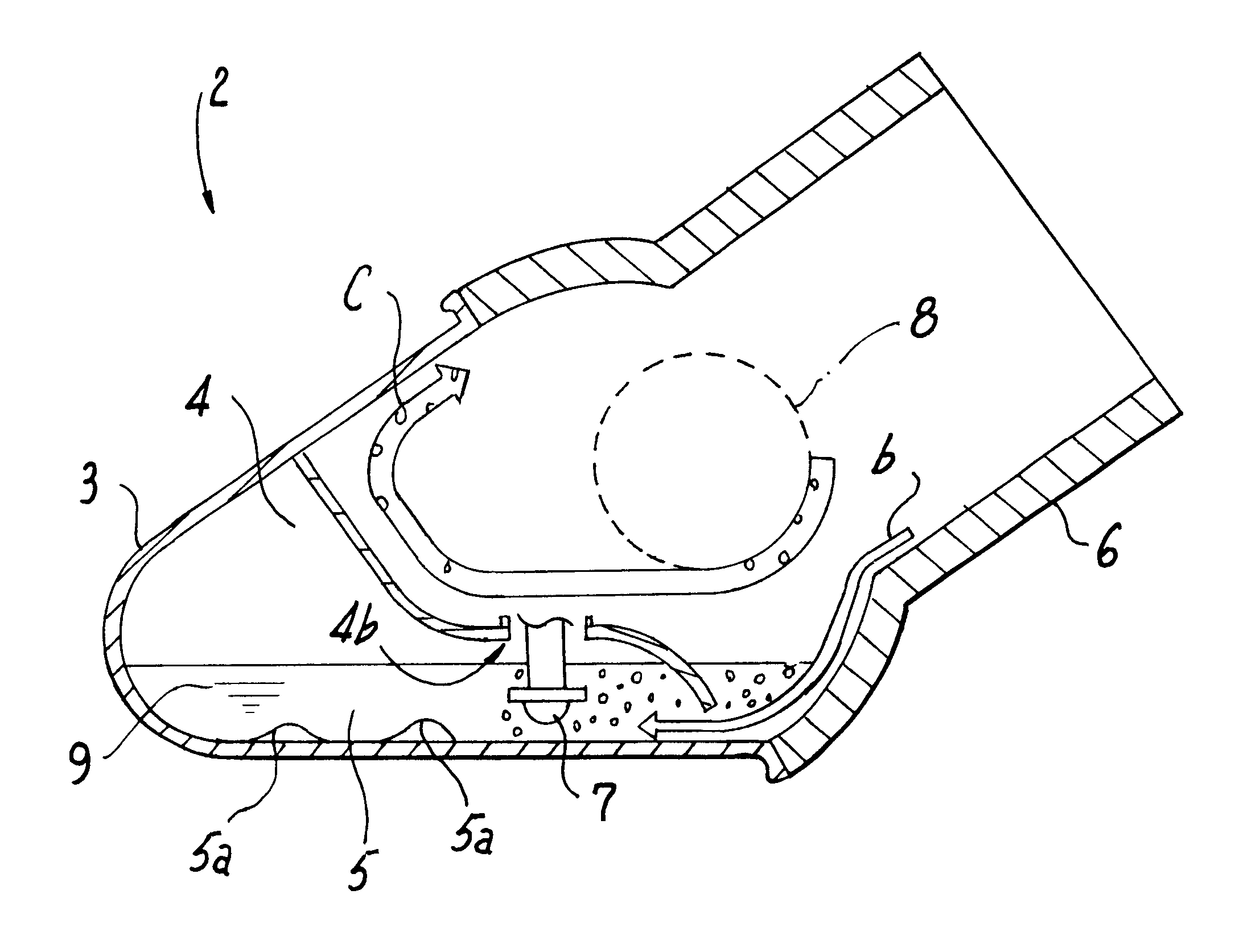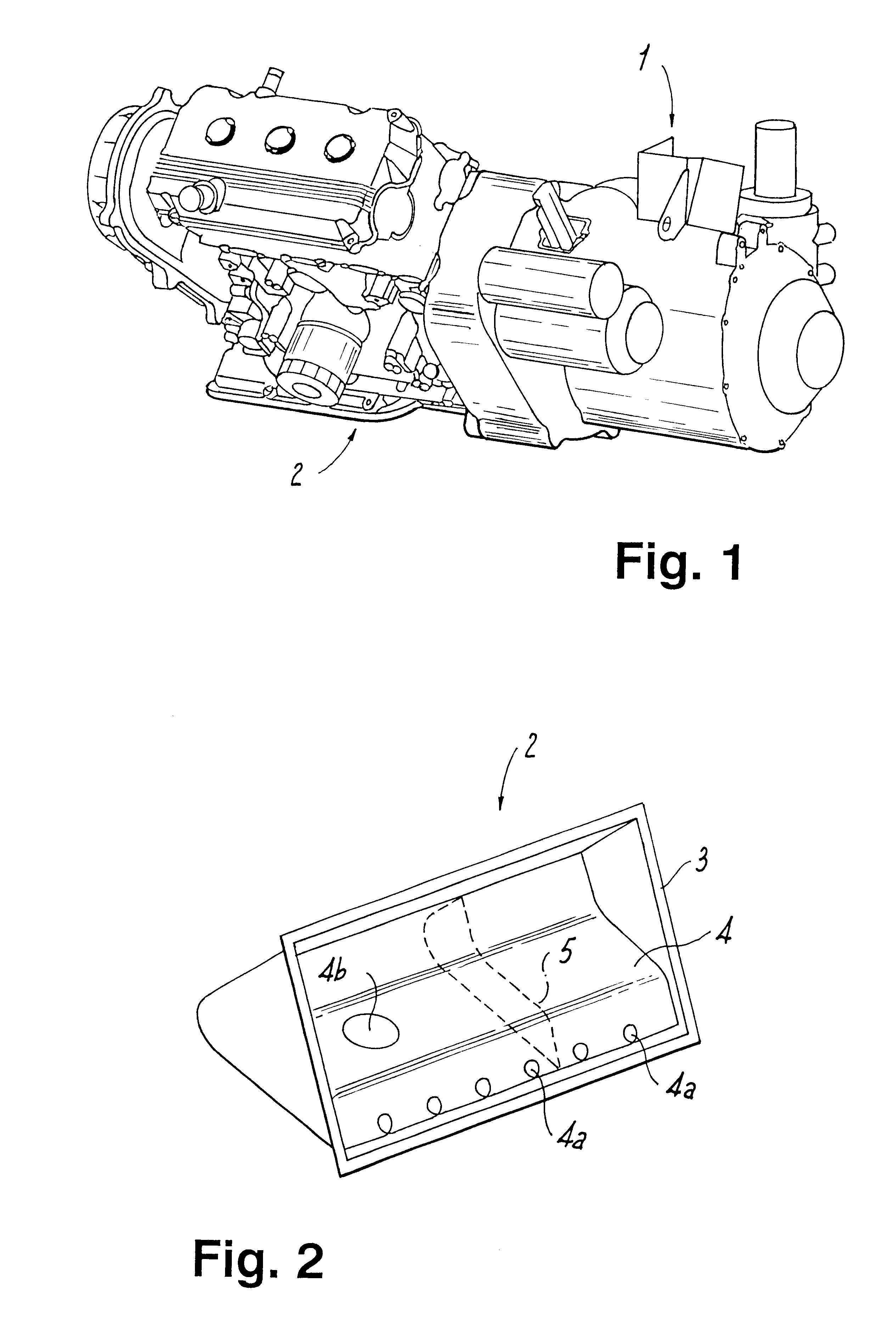Oil pan structure for internal combustion engine
a technology for internal combustion engines and oil pans, which is applied in the direction of casings, lubricant level maintenance, lubrication elements, etc., can solve problems such as deterioration of aeration performance, and achieve the effect of reducing aeration (mixed air percentage)
- Summary
- Abstract
- Description
- Claims
- Application Information
AI Technical Summary
Benefits of technology
Problems solved by technology
Method used
Image
Examples
first embodiment
FIG. 2 shows an oil pan 2 of an embodiment of the present invention. The oil pan 2 has a different shape from a regular tray-type oil pan. A housing 3 of the oil pan 2 is formed to have a side view of a triangle as shown in the figure. The housing 3 is a hollow triangular prism with one side face open. Since the oil pan 2 is secured to the engine 1 in such direction as shown in FIG. 2, the bottom face (one of the side faces of the hollow triangular prism, but not the open side face) in FIG. 2, which shows the oil pan 2 with the open side face of the hollow triangular prism facing towards the front, corresponds to the real bottom face, which is horizontal, when the oil pan 2 is fixed on the engine 1. Inside of the housing 3, a first baffle plate 4 is disposed horizontally with a certain distance from the bottom face of the oil pan 2 such that oil having air bubbles after lubricating elements may not drop from a cylinder block or a crank case directly to the surface of oil stored in t...
second embodiment
FIG. 3 shows another embodiment of the present invention. FIG. 3 is corresponding to FIG. 2 of the first embodiment and thus has only difference from FIG. 2 that the second baffle plate 5 has openings 5a (second openings) near the bottom of the oil pan2. Since the second baffle plate 5 has openings 5a (second openings), oil may pass through the openings, as indicated by an arrow `a,` between two compartments partitioned by the second baffle plate 5 such that the oil surface height of each compartment may not be very different. Since the openings 5a (second openings) are made near the bottom face of the oil pan 2, mixed air bubbles, which tend to float upper with buoyancy, are hard to pass the openings 5a (second openings). Therefore, the compartment, into which the oil flows through the openings 5a (second openings), stores oil having relatively less air bubbles.
FIG. 4 is an I--I sectional view of FIG. 3 from the left hand side. The figure illustrates how the oil pan 2 is fixed on t...
third embodiment
FIG. 6 shows another embodiment of the present invention, FIG. 7 shows an III--III sectional view of FIG. 6 from the left hand side. FIG. 8 is a IV--IV sectional view of FIG. 6 from the left hand side. These figures are corresponding to FIGS. 3, 4, and 5 of the previous embodiment and are only different in an opening as mentioned below. In the third embodiment, the first baffle plate 4 has an oil dropping hole 4c (third opening) from the cylinder block side over one compartment, where the oil strainer 7 is not disposed, of the two compartments partitioned by the second baffle plate 5. Thus, with the hole 4c (third opening), as shown in FIG. 8, most oil circulating clockwise around the crankshaft 8 in accordance with the crankshaft 8 rotation drops through the hole 4c (third opening) to the bottom of the oil pan 2. Then, oil with relatively large amount of mixed air bubbles is stored in the compartment in which the oil strainer 7 is not disposed, flows to the other compartment throug...
PUM
 Login to View More
Login to View More Abstract
Description
Claims
Application Information
 Login to View More
Login to View More - R&D
- Intellectual Property
- Life Sciences
- Materials
- Tech Scout
- Unparalleled Data Quality
- Higher Quality Content
- 60% Fewer Hallucinations
Browse by: Latest US Patents, China's latest patents, Technical Efficacy Thesaurus, Application Domain, Technology Topic, Popular Technical Reports.
© 2025 PatSnap. All rights reserved.Legal|Privacy policy|Modern Slavery Act Transparency Statement|Sitemap|About US| Contact US: help@patsnap.com



